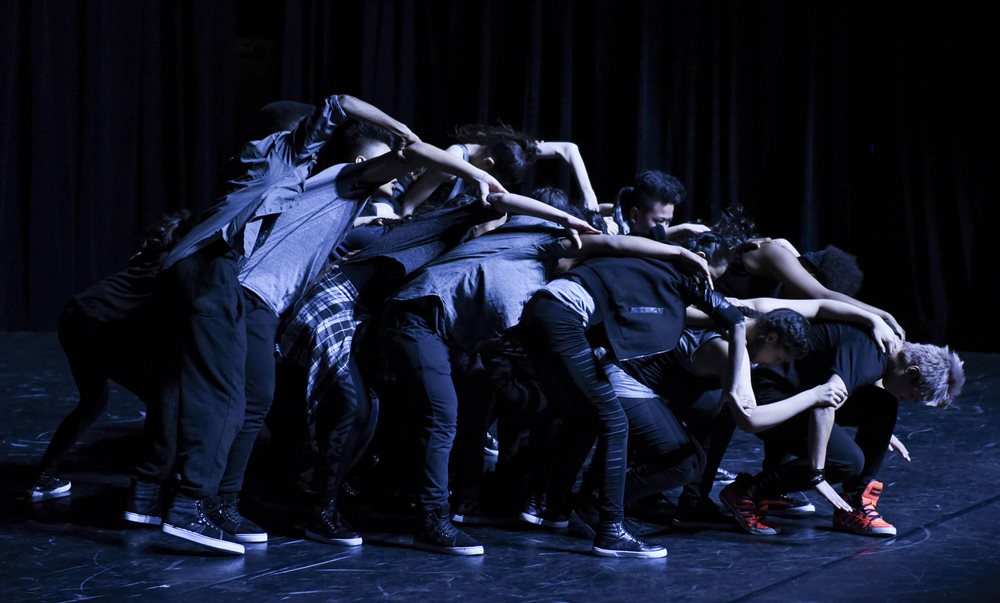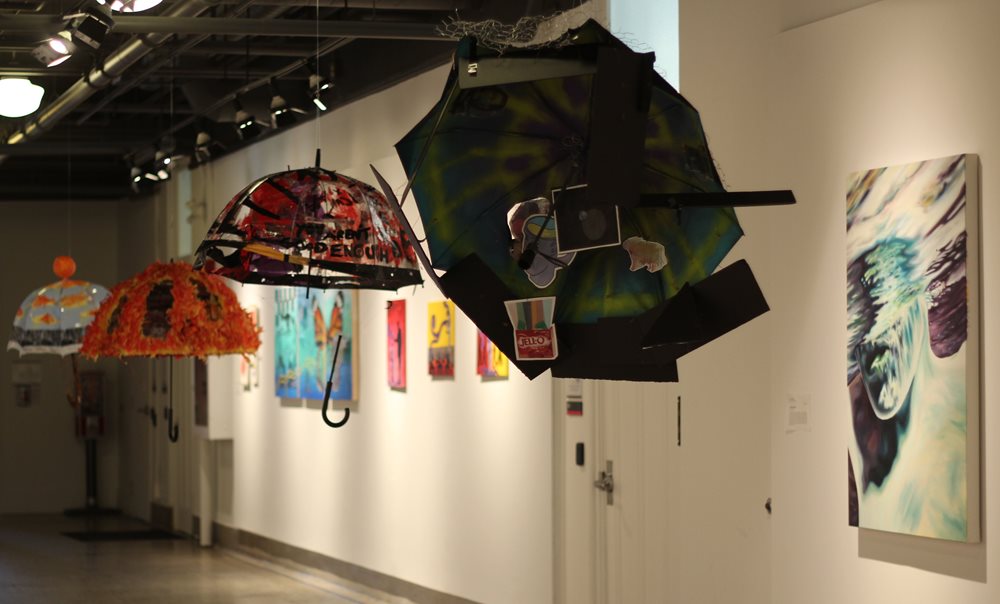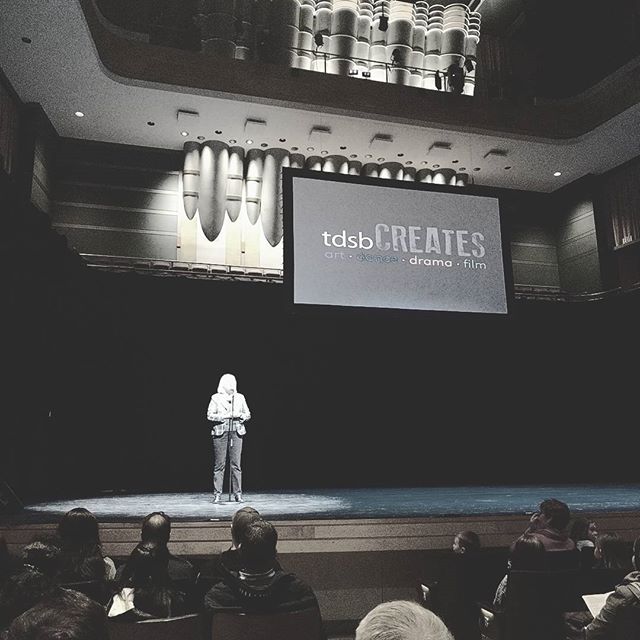tdsbCREATES: educating students through the arts
Featured Story: tdsbCREATES
May 2017
 TDSB students perform as part of the tdsbCREATES Dance and Spoken Word Showcase
TDSB students perform as part of the tdsbCREATES Dance and Spoken Word Showcase
Carrie Hage, an artist educator who specializes in theatre practice, believes that teaching the arts to students should never be an afterthought, or considered a special add-on. “Arts education is part of a full education,” she explains. “Arts education gives students a full range of opportunities and experiences… You’re teaching a practice that allows for discussions, observations and realizations, where every student has an opportunity to craft their own answers.” When learning through the arts, there is no right or wrong answer. This aspect of exploration and discovery is part of why being an artist educator is “incredibly rewarding” for Hage.
In addition to being an artist educator, Hage is also the Program Administrator at Prologue to the Performing Arts for the tdsbCREATES program, a four-week spring festival that includes artist residencies, mentorships and presentation events. The program was developed in 2014 through a partnership with Toronto Arts Council (TAC), Prologue to the Performing Arts, and the Toronto District School Board (TDSB).
 Artwork displayed as part of the tdsbCREATES Art and Film Exhibition
Artwork displayed as part of the tdsbCREATES Art and Film Exhibition
By leveraging the expertise and resources of Prologue, an organization that facilitates opportunities for young people to experience the performing arts in Ontario, and the TDSB with its nearly 600 schools across the GTA, TAC funding is able to have a greater impact. While Prologue accesses and manages artists within its comprehensive artist educator roster, the TDSB Arts Department matches artists with schools. In its first year, 42 schools participated in the program.
“tdsbCREATES is two programs within one big project,” Hage explains. The first involves artist residents, who work with elementary students (grades 1-6) in an exploratory way. There is no expectation to produce a final product with the elementary students. The second involves artist mentors working with students in grades 7-12. For these students, the goal is to develop a final product, which is presented to family, teachers and friends during the Dance and Spoken Word Showcase (presented at the Toronto Centre for the Arts) or Art and Film Exhibition (presented at Artscape Youngplace). Over three invigorating days a jury selects the works that will appear in the Showcase, and artists may be hired for additional hours to work with students to perfect their selected pieces.
 TAC Director and CEO Claire Hopkinson welcomes guests at the tdsbCREATES Dance and Spoken Word Showcase
TAC Director and CEO Claire Hopkinson welcomes guests at the tdsbCREATES Dance and Spoken Word Showcase
“Those three [juried] days are so special because of the sense of community. All of the schools come together to support each other... There’s something very special with having professional artists coming into the classroom and working with students," says Hage, who mentions that there's excellence in the work that's produced.
Bringing artist educators into the classroom is vital to the successful delivery of the arts curriculum, as set by the Ministry of Education. Not all schools have specialty arts-focused teachers, meaning many teachers receive a mere 12 hours of training for the delivery of the arts curriculum. The expertise that artist educators bring ensures that students receive high quality, professional instruction, and exposes teachers to new ways of exploring topics.
Hage tells a story about a classroom she visited where an artist educator was teaching grade 5 students how to make bird masks. The residency explored bird migration and the theme of change. Students were asked to do research on birds, and then design a mask based on their chosen bird. A conversation emerged about the theme of leaving a nest. “Students began talking about what in their lives was comparable to leaving a nest, like entering another year of school, or doing things where you’re taking a bit of a risk, or when there’s a change. It was one of these perfect moments that showed how using metaphor could open up deep conversations.”
Hage notes that the students in these programs aren’t from performing arts schools, and being an artist or performer may not be their dream. But the tdsbCREATES program nevertheless enriches them. It offers an opportunity to celebrate their thoughts and ideas, to try something new, to develop powerful pieces, and to collaborate with their peers. tdsbCREATES not only allows for the expression of the individual, but it celebrates it.
tdsbCREATES is lead by the TDSB Arts Department
Learn more about Prologue to the Performing Arts: prologue.org
Learn more about the tdsbCREATES program: www.tdsb.on.ca/HighSchool/GetInvolved/TDSBCreates.aspx
For information on tdsbCREATES, contact TDSB Arts Deptartment Program Coordinator, Lorraine Sutherns at lorraine.sutherns@tdsb.on.ca
Did you know:
- Artist educators and teachers that participate in the tdsbCREATES program are encouraged to work together to accomplish the objectives and outcomes for the students.
- 75% of TAC funding in the tdsbCREATES program goes directly to artist fees.
- In 2017, the tdsbCREATES program employed 34 mentors, and 40 resident artists.
- At-risk students who got involved in the arts, compared with students who had little or no arts exposure, have higher secondary school graduation rates; higher overall grade-point averages; higher math grade-point averages; higher test scores in science and writing; and are more likely to pursue post-secondary education.1
- Music education has been found to speed the development of speech and reading skills; help train children to focus their attention for sustained periods; and help them gain a sense of empathy for others.2
- 1,522,532 students participated in 13,390 activities and programs for children and youth, offered by Toronto-based, Ontario Arts Council operating clients.3
- 83% of Canadian parents believe that engaging children in the arts is important for their development. 4
- 80% of Torontonians see arts education programs in schools as being important. 5
Works Referenced
1 National Endowment for the Arts (2012). The Arts and Achievement in At-Risk Youth. http://arts.gov/sites/default/files/Arts-At-Risk-Youth.pdf
2 The Royal Conservatory of Music (2014). The Benefits of Music Education. https://www.rcmusic.ca/sites/default/files/files/RCM_MusicEducationBenefits.pdf
3 Hill Strategies Research and Creative Trust/PAONE (2011). The Performing Arts Education Overview. http://www.creativetrust.ca/wp-content/uploads/2011/12/PAEO-Report-FINAL-REV.pdf
4 Business for the Arts and AIMIA (2015). Canadians Value Companies That Support the Arts. http://www.businessforthearts.org/research-initiative/
5 Toronto Arts Foundation and Leger (2016). Toronto Arts Stats: Public Opinion 2016. http://www.torontoartsfoundation.org/knowledge-center/toronto-arts-stats